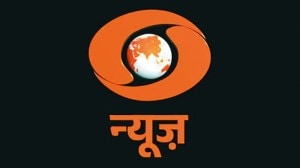- India
- International
Raja Mandala: The moon and the law
There is valuable real estate for space-faring nations on the lunar surface. But international law is still unclear on ownership in space.
 Indias second Moon mission Chandrayaan-2 lifts off onboard GSLV Mk III-M1 launch vehicle from Satish Dhawan Space Center at Sriharikota in Andhra Pradesh, Monday, July 22, 2019. (PTI)
Indias second Moon mission Chandrayaan-2 lifts off onboard GSLV Mk III-M1 launch vehicle from Satish Dhawan Space Center at Sriharikota in Andhra Pradesh, Monday, July 22, 2019. (PTI)
When Chandrayaan 2 arrives at the moon in a few weeks from now, it will seek to soft-land the lunar module, Vikram with its rover, Pragyan, on a site between two large craters in the south polar region. India is not the only one interested in the moon’s south pole. Other countries as well as private corporations are aiming at the same area; for a good reason — the lunar south pole has places where the sun never sets.
These places are called “Peaks of Eternal Light”— points on any celestial body that receive sunlight through the year. There are barely any peaks that have “eternal” or permanent illumination. But there are some which have light for a large part of the year. The moon has these peaks on its polar regions. The peaks in the south polar region are considered more attractive than those in the north.
Near permanent sunlight facilitates the establishment of lunar stations with assured supply of solar energy. Some of these peaks are fortunately located next to areas that are in permanent darkness and hold significant reserves of lunar ice. Many recent surveys, including those by Chandrayaan 1, have identified the presence of water in the polar regions. Having easy access to water is obviously critical to a sustainable human presence on the moon.
Water can also be broken down into hydrogen and oxygen, which in turn can be turned into rocket fuel. With moon’s low gravity, space vehicles need a lot less fuel than on earth for take-off. That could make the moon a convenient way-station from which human explorers could travel to other celestial bodies. Mars is already in the sights of many space-faring nations.
Right now, the moon rush on the earth is aimed at the lunar south pole. In January this year, China’s Chang’e 4 soft-landed in the Von Karman crater on the dark side of the south polar region. China hopes to build a lunar robotic station near the south pole in little more than a decade.

The US lunar programme, revived by the Trump Administration, now aims to put man back on the moon in the next decade. NASA’s focus is on the south pole and if it succeeds, it will be the first manned crew to arrive at the south pole.
NASA, however, has some competition at home from Amazon’s Jeff Bezos. In May this year, Bezos unveiled the Blue Moon project that seeks to land men and women on the moon in the next few years. “It’s time to go back to the moon and this time stay,” Bezos said. Bezos wants to land two tons of cargo on each mission and start building a lunar base at the Shackleton Crater, very close to the lunar south pole. It is named after Ernest Shackleton who explored the earth’s south pole in the Antarctic.
As a lunar race unfolds, the world will run, sooner than later, into difficult problems about such mundane issues as property rights. The international law of outer space is now defined by the 1967 Outer Space Treaty. The OST is quite explicit in affirming that outer space and celestial bodies like the moon can’t be “appropriated” by any nation through claims of sovereignty, occupation or any other means. It calls the exploration and use of outer space “shall be the province of all mankind”.
Like so much in law, one principle often contradicts another. The OST also wants states to show “due regard to the corresponding interests of all other States Parties to the Treaty”. The interpretation of these principles is becoming contentious as the world’s space-faring nations come to terms three important facts.
The “peaks of eternal light” constitute the most valuable real estate on the moon; they come in small patches and are in short supply. If the principle of respecting “corresponding interests” means “non-interference” in the pre-existing lunar activity of another state, some international lawyers worry, we could end up with up de-facto ownership for those who show up first on the peaks of eternal light.
Quite clearly, this is a recipe for competition and conflict on the moon. To make matters worse, the Outer Space Treaty has no provision for effective dispute resolution. The OST certainly exhorts states to cooperate and extend mutual assistance to each other in outer space. It also calls for consultations when conflicts arise. That inevitably takes us out of the legal and into the political domain.
There is also contention on another question — who owns the resources of the moon? In a law approved in 2015, the US has authorised its citizens to own, transport and sell resources exploited on the moon. Washington argues that this provision does not violate OST’s principle of “non-appropriation” of the moon’s territory. Tiny Luxembourg has passed a similar law to attract companies interested in space mining. The UAE is expected to follow suit soon.
As India celebrates the successful launch of Chandrayaan 2, Delhi needs to match the extraordinary success of its scientists with sustained diplomatic effort at the highest level. Amidst the growing scale and scope of humanity’s lunar adventure, the Foreign Office needs to take up international space cooperation as a strategic priority. It also needs to develop a stronger political voice for India in shaping new rules for the moon and outer space.
The writer is director, Institute of South Asian Studies, National University of Singapore and contributing editor on international affairs for The Indian Express
EXPRESS OPINION
More Explained
Apr 20: Latest News
- 01
- 02
- 03
- 04
- 05









































